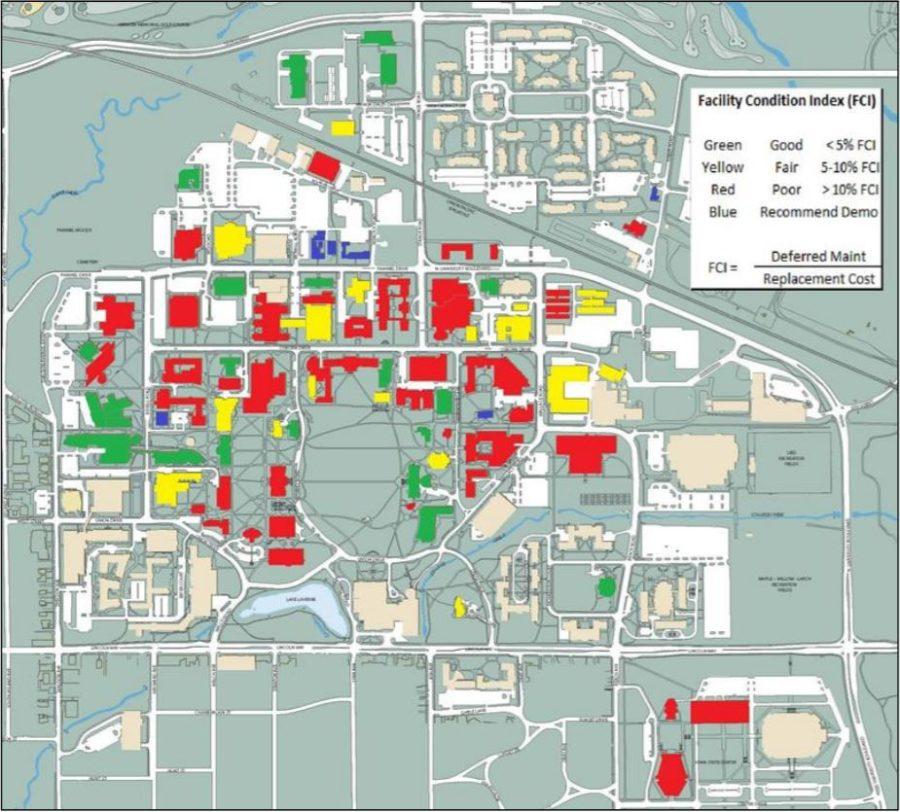More than $436 million needed in building repairs, Facilities Planning and Management says
A central campus map shows the condition of various facilities. Among the buildings in need of critical repairs are Bessey, Kildee and Carver halls.
September 13, 2018
Iowa State’s campus may be beautiful, but it’s also old.
Paul Fuligni, associate vice president for facilities, planning and management at Iowa State, works to oversee the aging buildings on campus for what they are and keep them running smoothly. However, that is becoming an increasingly hard task.
On Sept. 5, Fuligni presented his analysis on the condition of Iowa State’s maintenance needs to the Professional and Scientific Council of Iowa State. What he found was “scary,” he said.
In his presentation, Fuligni gave a lot of attention to the amount of maintenance needed on campus that has been piling up over the years. But one number garnered a lot more attention than the rest — it will cost Iowa State $436 million to complete the backlog of deferred maintenance waiting to be fixed on campus.
“It’s staggering,” Fuligni said.
Deferred maintenance is any repair or replacement of a building component or system that could not be fixed due to insufficient funds, Fuligni said.
Fuligni acknowledges that the first few years of a backlogged project is generally not a big deal, but said that as the problem continues to degrade, the general comfort or usability in that space begins to deteriorate.
“You’re probably not taking a lot of risk on the systems breaking down or failing on you,” Fuligni said. “But over time, they will start failing… and it starts driving a need for more short-term repairs, band-aid repairs.
“You have to react more than doing planned work that we may want to want to do [and] it starts interrupting people in classes, people in their offices, researchers in their labs,” he said.
Fuligni has pointed to 12 academic and research buildings on campus that have been requesting the most calls for repairs and have the highest backlog. Dubbed the “bottom 12”, these buildings are in need of “critical” repairs such as roof, elevator, and HVAC (heating and air conditioning) repairs.
Gilman tops the list with more than $28 million in deferred maintenance, with the Design Building coming in second with nearly $16.5 million in needed repairs.
These numbers are just what the backlog currently costs; the maintenance staff still continue to repair smaller issues on a regular basis.
“For the dozen buildings we identified we are getting two, three hundred calls per year for a single building,” Fuligni said. “And of course you start extending that around campus, it adds up pretty quick.”
However, it is becoming more difficult for the Facilities Planning and Management (FPM) to repair even simple things, as reductions in state appropriations and salary increases for the faculty staff recently led to $500,000 in budget cuts each year for the FPM general fund.
“That will reduce the funds available for smaller maintenance repairs we did around campus, so it’s a reduction in the resources available and we will have to just account for that as we allocate money and prioritize projects,” Fuligni said.
Last year, FPM spent roughly $7.1 million on normal maintenance and $5 million on the backlog, or roughly $12 million total on maintenance. This year, they plan to raise that to $16 million to help with the backlog, Fuligni said.
In order to completely wipe out the backlog, Iowa State would need to pay $43 million per year. Just to cut the figure in half would take 10 years and cost $23 million per year. This would be unaffordable, said Fuligni at the council meeting.
Iowa State is not alone in this issue. On Wednesday, Fuligni reported Iowa State’s backlog of maintenance repairs to the Iowa Board of Regents, along with the University of Iowa and University of Northern Iowa.
“We all have very similar issues in that we have aging facilities, we probably have less resources than we would like to go towards those and obviously those conditions are of some concern in terms of how they impact the teaching and research and the staff, faculty and students on campus,” Fuligni said.







